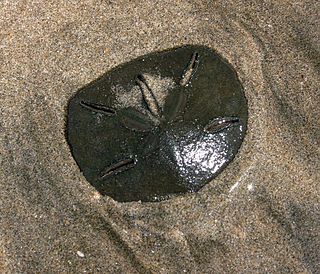
The Echiura, or spoon worms, are a small group of marine animals. Once treated as a separate phylum, they are now considered to belong to Annelida. Annelids typically have their bodies divided into segments, but echiurans have secondarily lost their segmentation. The majority of echiurans live in burrows in soft sediment in shallow water, but some live in rock crevices or under boulders, and there are also deep sea forms. More than 230 species have been described. Spoon worms are cylindrical, soft-bodied animals usually possessing a non-retractable proboscis which can be rolled into a scoop-shape to feed. In some species the proboscis is ribbon-like, longer than the trunk and may have a forked tip. Spoon worms vary in size from less than a centimetre in length to more than a metre.

Sand dollars are species of flat, burrowing sea urchins belonging to the order Clypeasteroida. Some species within the order, not quite as flat, are known as sea biscuits. Sand dollars can also be called "sand cakes" or "cake urchins".

Bucculatricidae or (Bucculatrigidae) is a family of moths. This small family has representatives in all parts of the world. Some authors place the group as a subfamily of the family Lyonetiidae.

Keyhole sand dollar refers to three species of sand dollars in the genus Mellita. They are found on the Atlantic coasts of the Americas, ranging from Caribbean Islands, such as Jamaica and Puerto Rico, to the southern areas of the United States at the north to the southern coasts of Brazil at the south. Their range includes Bermuda and the Pacific coasts of equatorial countries, such as Mexico and Costa Rica also found in Honduras.

Navarretia is a genus of about 30 species of flowering plants related to the phloxes and the gilias. This is one genus of plants, among others, which are sometimes called pincushion plants. The inflorescence which bears the flowers is surrounded by frilly green bracts bearing soft spines, giving it the appearance of a pincushion. Several species are members of the vernal pool ecosystem.

Gharbi is the second largest of the Kerkennah Islands off the north coast of Tunisia. The name means "Westerner" in Arabic. Chief town is Mellita. It is located 20 km away from the Sfax coast. The island has an area of 69 km2. The largest island of the group, Chergui, means "Easterner" in Arabic.

Necydalis mellita is a longhorn beetle in the family Cerambycidae.

Pseudosphex is a genus of tiger moths in the family Erebidae. The genus was erected by Jacob Hübner in 1818. These moths are mimics of a variety of Hymenoptera. The prefix pseudo means "false", and Sphex is a genus of wasps.

Tamazight of Djerba, Shilha of Djerba, Djerbi or Djerbian is a Berber language of the Eastern Maghreb, spoken on the island of Djerba, in Tunisia. It is a component of what is regularly denominated Tunisian "Shilha" or "Chelha" in the south of the country.

Mellita quinquiesperforata is a tropical species of sand dollar, a flat, round marine animal related to sea urchins, starfish, and other echinoderms. They can be found along the eastern coast of the United States and the coast of Brazil.

The sea urchins of the Gulf of California live between the coasts of the Baja California Peninsula to the west and mainland state of Sonora, Mexico to the east. The northern boundary is the lateral band of land with the remains of the Colorado River Delta, and the southern is the Pacific Ocean.

Necydalis is a genus of beetles in the family Cerambycidae: that appears to be mostly distributed in the Oriental and Palaearctic realms.
Bucculatrix mellita is a moth in the family Bucculatricidae. It was described by Edward Meyrick in 1915. It is found in Peru.

Irregularia is an extant infraclass of sea urchins that first appeared in the Lower Jurassic.
Okenia mellita is a species of sea slug, specifically a dorid nudibranch, a marine gastropod mollusc in the family Goniodorididae.

Iris attica, the Greek iris, is a plant species in the genus Iris, it is also in the subgenus Iris. It is a rhizomatous perennial, from the mountains of the Balkans in Europe, within the countries of Greece, former Yugoslavia, Turkey and North Macedonia. It has sage green or grey-green leaves, that are sickle-shaped, a stout short stem and 2 variable flowers, in shades from yellow to purple. They have a white or blue beard. It is often called Iris pumila subsp attica, but is classified in most sources, as a separate species, although it is closely related to Iris pumila, as a possible parent plant. It is cultivated as an ornamental plant in temperate regions.

Iris suaveolens is a plant species in the genus Iris, it is also in the subgenus Iris. It is a rhizomatous perennial, from Eastern Europe, ranging from the Balkans to Turkey. It has short, sickle shaped or curved, blue-green or greyish green leaves, a slender simple stem, with 1 or 2 fragrant spring blooming, flowers, between yellow and purple, with white or yellow beards. It was once known as Iris mellita, until that was re-classified as a synonym of Iris suaveolens. It is cultivated as an ornamental plant in temperate regions.

Mellitidae is a family of sand dollars, in the echinoderm order Clypeasteroida. These irregular sea urchins bury themselves in soft sediment in shallow seas.














